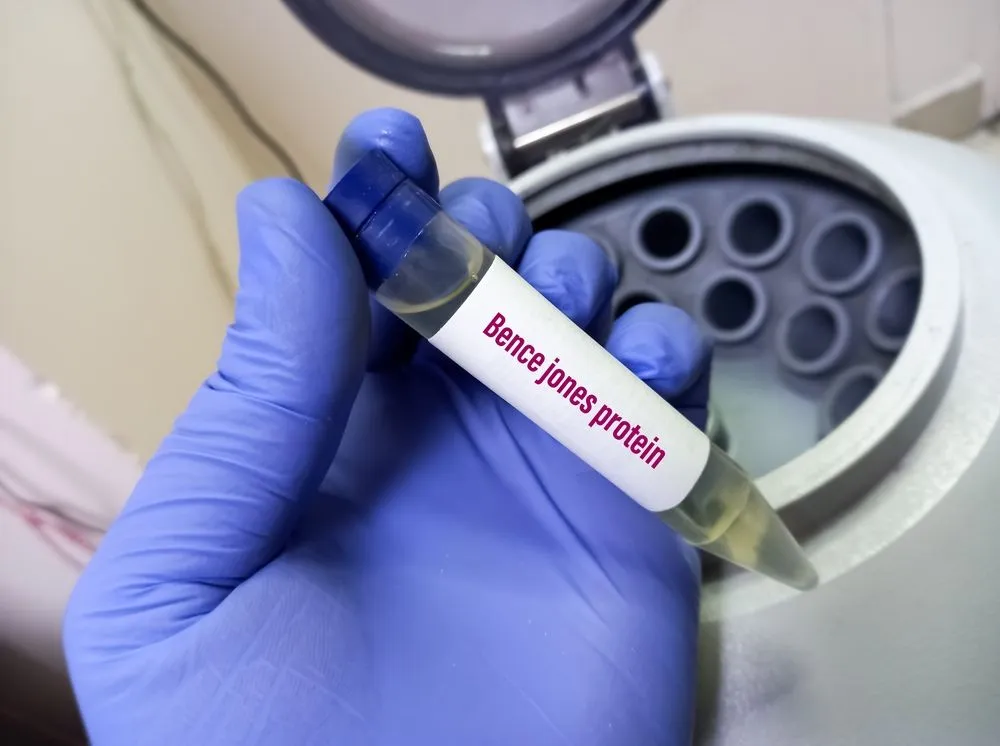What is Light-Chain Only Myeloma?

Multiple myeloma (MM) is the second most common blood cancer, representing 1% of all cancers. It originates in the bone marrow, which produces all blood cells and is characterized by an abnormal overproduction of plasma cells, which normally create antibodies and immunoglobulins to fight infections.
Due to mutations and other factors, the myeloma cells produce the monoclonal protein, heavy chains (IgG, IgA, etc.), and light chains (kappa or lambda). In rarer cases, they don’t produce monoclonal protein or heavy chains. Depending on what protein the abnormal plasma cells produce, multiple myeloma is categorized, treated, and monitored.
Light-chain multiple myeloma (LCMM) or light-chain-only multiple myeloma is a specific subtype of multiple myeloma, making up around 15% of all multiple myeloma cases. In light-chain-only myeloma, abnormal plasma cells only produce light-chain proteins (kappa or lambda) instead of both heavy and light chains, leading to unique clinical challenges and manifestations.
What Can Plasma Cells Produce in Multiple Myeloma?
In normal conditions, plasma cells produce immunoglobulins, proteins that help the immune system identify infections or harmful substances in the body.
-
Kappa and lambda light chains: patients can produce both types, although most patients only produce one type (the most common is kappa). Sometimes, it shifts from kappa to lambda or vice versa, but it’s rare. And even more rarely, some myeloma types can also stop producing light chains (non-secretory)
-
Immunoglobulins (heavy chains): IgG, IgM, IgE, IgA, and IgD. These are also produced in healthy patients. However, multiple myeloma causes an abnormal overproduction of these proteins. The most common is IgG with kappa light chains.
-
Monoclonal protein: also known as m-spike, m-protein, m-component, or paraprotein. This is specific to multiple myeloma.
-
Bence Jones protein: is more often found in urine and is less specific to multiple myeloma because it can be found in other blood cancers and some autoimmune disorders.
At HealthTree University, we featured Dr. Fonseca, one of the top myeloma specialists in the United States, to explain all you need to know about kappa and lambda light chains. Join HealthTree University to watch more videos like this, take quizzes, and track your progress in understanding multiple myeloma.
What are the Symptoms of Light-Chain-Only Myeloma? z
Abnormal plasma cells overproducing proteins can cause consequential problems in the body. The kidneys, in particular, can become overwhelmed by the high concentration of light chains, potentially leading to kidney failure. Bone disease and systemic light-chain amyloidosis (a condition where abnormal proteins accumulate in organs and tissues) are also more common in patients with light-chain-only myeloma.
The common symptoms in multiple myeloma appear across all subtypes. For example, the CRAB Symptoms include high calcium levels (C), kidney failure (R), anemia (A), and bone loss (B).
-
Hypercalcemia: high calcium levels in blood, often caused by bone destruction.
-
Kidney (renal) failure or injury: often due to the accumulation of light chains in the kidneys.
-
Anemia: low red blood cell counts, leading to fatigue and weakness.
-
Bone Disease: lytic bone lesions, which are areas of bone loss that may result in fractures or pain.
Additionally, light-chain-only myeloma has other frequent symptoms, such as:
-
Frequent infections: although there are many circulating proteins that, under normal circumstances, work in favor of the immune system, keep in mind that these are being produced by abnormal cells and are not performing their usual duties for that reason. This results in a weakened immune system, making the body more prone to infections.
-
Amyloidosis: this is a diagnosis that requires a biopsy to be confirmed. It is caused by the accumulation of light chains or proteins in various organs, and this is not exclusive to light-chain-only myeloma. If you want to keep learning about amyloidosis, you can join our community in the amyloidosis group.
How is Light-Chain-Only Multiple Myeloma Diagnosed?
It’s important to remember that in this condition, there isn’t an overproduction of heavy chains, so in routine myeloma labs, the levels may appear normal. To diagnose light chain only myeloma, just like in other multiple myeloma subtypes or precursors like smoldering myeloma, a series of tests is required:
-
Blood and urine tests: These measure the levels of light chains and other myeloma indicators (M-protein, Bence Jones protein) in the body.
-
Bone marrow biopsy: This is performed to analyze and count the plasma cells in the bone marrow.
-
Imaging studies: MRI or CT scans are used to detect bone damage or plasmacytomas (tumors formed by plasma cells).
-
Free light chain assays: These specialized tests measure the ratio of kappa to lambda light chains and the quantity of each kappa and lambda light chains circulating in the blood.
To learn more about tests in multiple myeloma, read our comprehensive resource Understanding Your Myeloma Labs. We have a free printable version that you can take with you to your office visits!
What are Treatments for Light Chain Only Multiple Myeloma?
Light-chain-only myeloma is often considered more aggressive than other forms of multiple myeloma. The prognosis can be poorer due to the higher likelihood of kidney damage and the presence of conditions like amyloidosis.
Bortezomib (a type of proteasome inhibitor), combined with other agents, has shown superior efficacy compared to other treatments. It targets the mechanisms that allow myeloma cells to grow and produce excessive light chains, helping to control the disease more effectively.
Besides bortezomib, other treatment options include:
-
Immunomodulatory drugs: help enhance the immune system's ability to eliminate cancer cells.
-
Stem Cell Transplant: is often used to improve long-term outcomes.
-
Corticosteroids: help to reduce inflammation and suppress myeloma cell activity.
-
Chemotherapy: works specifically by targeting cancer cells that are in the process of dividing. The most common use of conventional chemotherapy in myeloma is using melphalan to kill myeloma cells before a stem cell transplant.
-
Clinical trials: can be a great alternative as they provide access to new treatments before they become widely available, potentially offering better outcomes for patients with limited treatment options.
Conclusion
In conclusion, light-chain multiple myeloma is a unique and challenging subtype of multiple myeloma. Early detection and personalized treatment can manage symptoms and improve outcomes. By understanding their disease, patients can make informed decisions and actively participate in their care. Advanced treatments like bortezomib-based regimens and stem cell transplants offer better results.
Become Your Best Self-Advocate Today by Creating a Free HealthTree Account
Learning about light chain myeloma can feel overwhelming. Save videos about this topic and more in HealthTree University by creating an account so you can continue your learning at a pace that works for you.
Sources:
Multiple myeloma (MM) is the second most common blood cancer, representing 1% of all cancers. It originates in the bone marrow, which produces all blood cells and is characterized by an abnormal overproduction of plasma cells, which normally create antibodies and immunoglobulins to fight infections.
Due to mutations and other factors, the myeloma cells produce the monoclonal protein, heavy chains (IgG, IgA, etc.), and light chains (kappa or lambda). In rarer cases, they don’t produce monoclonal protein or heavy chains. Depending on what protein the abnormal plasma cells produce, multiple myeloma is categorized, treated, and monitored.
Light-chain multiple myeloma (LCMM) or light-chain-only multiple myeloma is a specific subtype of multiple myeloma, making up around 15% of all multiple myeloma cases. In light-chain-only myeloma, abnormal plasma cells only produce light-chain proteins (kappa or lambda) instead of both heavy and light chains, leading to unique clinical challenges and manifestations.
What Can Plasma Cells Produce in Multiple Myeloma?
In normal conditions, plasma cells produce immunoglobulins, proteins that help the immune system identify infections or harmful substances in the body.
-
Kappa and lambda light chains: patients can produce both types, although most patients only produce one type (the most common is kappa). Sometimes, it shifts from kappa to lambda or vice versa, but it’s rare. And even more rarely, some myeloma types can also stop producing light chains (non-secretory)
-
Immunoglobulins (heavy chains): IgG, IgM, IgE, IgA, and IgD. These are also produced in healthy patients. However, multiple myeloma causes an abnormal overproduction of these proteins. The most common is IgG with kappa light chains.
-
Monoclonal protein: also known as m-spike, m-protein, m-component, or paraprotein. This is specific to multiple myeloma.
-
Bence Jones protein: is more often found in urine and is less specific to multiple myeloma because it can be found in other blood cancers and some autoimmune disorders.
At HealthTree University, we featured Dr. Fonseca, one of the top myeloma specialists in the United States, to explain all you need to know about kappa and lambda light chains. Join HealthTree University to watch more videos like this, take quizzes, and track your progress in understanding multiple myeloma.
What are the Symptoms of Light-Chain-Only Myeloma? z
Abnormal plasma cells overproducing proteins can cause consequential problems in the body. The kidneys, in particular, can become overwhelmed by the high concentration of light chains, potentially leading to kidney failure. Bone disease and systemic light-chain amyloidosis (a condition where abnormal proteins accumulate in organs and tissues) are also more common in patients with light-chain-only myeloma.
The common symptoms in multiple myeloma appear across all subtypes. For example, the CRAB Symptoms include high calcium levels (C), kidney failure (R), anemia (A), and bone loss (B).
-
Hypercalcemia: high calcium levels in blood, often caused by bone destruction.
-
Kidney (renal) failure or injury: often due to the accumulation of light chains in the kidneys.
-
Anemia: low red blood cell counts, leading to fatigue and weakness.
-
Bone Disease: lytic bone lesions, which are areas of bone loss that may result in fractures or pain.
Additionally, light-chain-only myeloma has other frequent symptoms, such as:
-
Frequent infections: although there are many circulating proteins that, under normal circumstances, work in favor of the immune system, keep in mind that these are being produced by abnormal cells and are not performing their usual duties for that reason. This results in a weakened immune system, making the body more prone to infections.
-
Amyloidosis: this is a diagnosis that requires a biopsy to be confirmed. It is caused by the accumulation of light chains or proteins in various organs, and this is not exclusive to light-chain-only myeloma. If you want to keep learning about amyloidosis, you can join our community in the amyloidosis group.
How is Light-Chain-Only Multiple Myeloma Diagnosed?
It’s important to remember that in this condition, there isn’t an overproduction of heavy chains, so in routine myeloma labs, the levels may appear normal. To diagnose light chain only myeloma, just like in other multiple myeloma subtypes or precursors like smoldering myeloma, a series of tests is required:
-
Blood and urine tests: These measure the levels of light chains and other myeloma indicators (M-protein, Bence Jones protein) in the body.
-
Bone marrow biopsy: This is performed to analyze and count the plasma cells in the bone marrow.
-
Imaging studies: MRI or CT scans are used to detect bone damage or plasmacytomas (tumors formed by plasma cells).
-
Free light chain assays: These specialized tests measure the ratio of kappa to lambda light chains and the quantity of each kappa and lambda light chains circulating in the blood.
To learn more about tests in multiple myeloma, read our comprehensive resource Understanding Your Myeloma Labs. We have a free printable version that you can take with you to your office visits!
What are Treatments for Light Chain Only Multiple Myeloma?
Light-chain-only myeloma is often considered more aggressive than other forms of multiple myeloma. The prognosis can be poorer due to the higher likelihood of kidney damage and the presence of conditions like amyloidosis.
Bortezomib (a type of proteasome inhibitor), combined with other agents, has shown superior efficacy compared to other treatments. It targets the mechanisms that allow myeloma cells to grow and produce excessive light chains, helping to control the disease more effectively.
Besides bortezomib, other treatment options include:
-
Immunomodulatory drugs: help enhance the immune system's ability to eliminate cancer cells.
-
Stem Cell Transplant: is often used to improve long-term outcomes.
-
Corticosteroids: help to reduce inflammation and suppress myeloma cell activity.
-
Chemotherapy: works specifically by targeting cancer cells that are in the process of dividing. The most common use of conventional chemotherapy in myeloma is using melphalan to kill myeloma cells before a stem cell transplant.
-
Clinical trials: can be a great alternative as they provide access to new treatments before they become widely available, potentially offering better outcomes for patients with limited treatment options.
Conclusion
In conclusion, light-chain multiple myeloma is a unique and challenging subtype of multiple myeloma. Early detection and personalized treatment can manage symptoms and improve outcomes. By understanding their disease, patients can make informed decisions and actively participate in their care. Advanced treatments like bortezomib-based regimens and stem cell transplants offer better results.
Become Your Best Self-Advocate Today by Creating a Free HealthTree Account
Learning about light chain myeloma can feel overwhelming. Save videos about this topic and more in HealthTree University by creating an account so you can continue your learning at a pace that works for you.
Sources:

about the author
Jimena Vicencio
Jimena is an International Medical Graduate and a member of the HealthTree Writing team. Currently pursuing a bachelor's degree in journalism, she combines her medical background with a storyteller’s heart to make complex healthcare topics accessible to everyone. Driven by a deep belief that understanding health is a universal right, she is committed to translating scientific and medical knowledge into clear, compassionate language that empowers individuals to take control of their well-being.
More on Core Education
Trending Articles
Get the Latest Blood Cancer Updates, Delivered to You.
By subscribing to the HealthTree newsletter, you'll receive the latest research, treatment updates, and expert insights to help you navigate your health.
Together we care.
Together we cure.
3x Faster.












